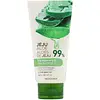What's inside
What's inside
 Key Ingredients
Key Ingredients

No key ingredients
 Benefits
Benefits

 Concerns
Concerns

 Ingredients Side-by-side
Ingredients Side-by-side

Aloe Barbadensis Leaf Extract
EmollientAlcohol Denat.
AntimicrobialGlycerin
HumectantPolysorbate 20
EmulsifyingCarbomer
Emulsion StabilisingTriethanolamine
BufferingBis-PEG-18 Methyl Ether Dimethyl Silane
EmollientGlyceryl Polyacrylate
Allantoin
Skin ConditioningBetaine
HumectantSodium Polyacrylate
AbsorbentCaprylyl Glycol
EmollientEthylhexylglycerin
Skin ConditioningCitrus Paradisi Seed Extract
MaskingArtemisia Princeps Extract
Skin ConditioningButylene Glycol
HumectantPolyglutamic Acid
Skin ConditioningLactobacillus/Aloe Barbadensis Ferment Filtrate
Skin ConditioningDipropylene Glycol
HumectantPentylene Glycol
Skin ConditioningMorus Alba Bark Extract
Skin ConditioningGlycine Soja Seed Extract
Skin ConditioningChamomilla Recutita Flower/Leaf Extract
AntimicrobialRosmarinus Officinalis Leaf Extract
AntimicrobialLavandula Angustifolia Flower Extract
CleansingOcimum Basilicum Leaf Extract
Skin ConditioningSalvia Officinalis Extract
AntimicrobialWater
Skin ConditioningDisodium EDTA
Phenoxyethanol
PreservativeParfum
MaskingChlorphenesin
AntimicrobialLimonene
PerfumingLinalool
PerfumingButylphenyl Methylpropional
PerfumingAloe Barbadensis Leaf Extract, Alcohol Denat., Glycerin, Polysorbate 20, Carbomer, Triethanolamine, Bis-PEG-18 Methyl Ether Dimethyl Silane, Glyceryl Polyacrylate, Allantoin, Betaine, Sodium Polyacrylate, Caprylyl Glycol, Ethylhexylglycerin, Citrus Paradisi Seed Extract, Artemisia Princeps Extract, Butylene Glycol, Polyglutamic Acid, Lactobacillus/Aloe Barbadensis Ferment Filtrate, Dipropylene Glycol, Pentylene Glycol, Morus Alba Bark Extract, Glycine Soja Seed Extract, Chamomilla Recutita Flower/Leaf Extract, Rosmarinus Officinalis Leaf Extract, Lavandula Angustifolia Flower Extract, Ocimum Basilicum Leaf Extract, Salvia Officinalis Extract, Water, Disodium EDTA, Phenoxyethanol, Parfum, Chlorphenesin, Limonene, Linalool, Butylphenyl Methylpropional
Aloe Barbadensis Leaf Juice
Skin ConditioningWater
Skin ConditioningLauryl Hydroxysultaine
CleansingMyristic Acid
CleansingLauric Acid
CleansingCocamidopropyl Betaine
CleansingPotassium Hydroxide
BufferingSodium Chloride
MaskingSodium Lauroyl Sarcosinate
CleansingBetula Platyphylla Japonica Juice
Skin ConditioningCucumis Sativus Extract
Skin ConditioningCentella Asiatica Extract
CleansingCitrullus Lanatus Fruit Extract
Skin ConditioningNelumbo Nucifera Flower Extract
Skin ConditioningZea Mays Silk Extract
Skin ConditioningPalmitic Acid
EmollientCapric Acid
CleansingDisodium EDTA
Phenoxyethanol
PreservativeChlorphenesin
AntimicrobialCaprylyl Glycol
EmollientEthylhexylglycerin
Skin ConditioningParfum
MaskingAloe Barbadensis Leaf Juice, Water, Lauryl Hydroxysultaine, Myristic Acid, Lauric Acid, Cocamidopropyl Betaine, Potassium Hydroxide, Sodium Chloride, Sodium Lauroyl Sarcosinate, Betula Platyphylla Japonica Juice, Cucumis Sativus Extract, Centella Asiatica Extract, Citrullus Lanatus Fruit Extract, Nelumbo Nucifera Flower Extract, Zea Mays Silk Extract, Palmitic Acid, Capric Acid, Disodium EDTA, Phenoxyethanol, Chlorphenesin, Caprylyl Glycol, Ethylhexylglycerin, Parfum
 Reviews
Reviews

Ingredients Explained
These ingredients are found in both products.
Ingredients higher up in an ingredient list are typically present in a larger amount.
Caprylyl Glycol is a humectant and emollient, meaning it attracts and preserves moisture.
It is a common ingredient in many products, especially those designed to hydrate skin. The primary benefits are retaining moisture, skin softening, and promoting a healthy skin barrier.
Though Caprylyl Glycol is an alcohol derived from fatty acids, it is not the kind that can dry out skin.
This ingredient is also used as a preservative to extend the life of products. It has slight antimicrobial properties.
Learn more about Caprylyl GlycolChlorphenesin is a synthetic preservative. It helps protect a product against bacteria in order to extend shelf life. In most cases, Chlorphenesin is paired with other preservatives such as phenoxyethanol and caprylyl glycol.
Chlorphenesin is a biocide. This means it is able to help fight the microorganisms on our skin. It is also able to fight odor-releasing bacteria.
Chlorphenesin is soluble in both water and glycerin.
Studies show Chlorphenesin is easily absorbed by our skin. You should speak with a skincare professional if you have concerns about using Chlorphenesin.
Learn more about ChlorphenesinDisodium EDTA plays a role in making products more stable by aiding other preservatives.
It is a chelating agent, meaning it neutralizes metal ions that may be found in a product.
Disodium EDTA is a salt of edetic acid and is found to be safe in cosmetic ingredients.
Learn more about Disodium EDTAEthylhexylglycerin (we can't pronounce this either) is commonly used as a preservative and skin softener. It is derived from glyceryl.
You might see Ethylhexylglycerin often paired with other preservatives such as phenoxyethanol. Ethylhexylglycerin has been found to increase the effectiveness of these other preservatives.
Parfum is a catch-all term for an ingredient or more that is used to give a scent to products.
Also called "fragrance", this ingredient can be a blend of hundreds of chemicals or plant oils. This means every product with "fragrance" or "parfum" in the ingredients list is a different mixture.
For instance, Habanolide is a proprietary trade name for a specific aroma chemical. When used as a fragrance ingredient in cosmetics, most aroma chemicals fall under the broad labeling category of “FRAGRANCE” or “PARFUM” according to EU and US regulations.
The term 'parfum' or 'fragrance' is not regulated in many countries. In many cases, it is up to the brand to define this term.
For instance, many brands choose to label themselves as "fragrance-free" because they are not using synthetic fragrances. However, their products may still contain ingredients such as essential oils that are considered a fragrance by INCI standards.
One example is Calendula flower extract. Calendula is an essential oil that still imparts a scent or 'fragrance'.
Depending on the blend, the ingredients in the mixture can cause allergies and sensitivities on the skin. Some ingredients that are known EU allergens include linalool and citronellol.
Parfum can also be used to mask or cover an unpleasant scent.
The bottom line is: not all fragrances/parfum/ingredients are created equally. If you are worried about fragrances, we recommend taking a closer look at an ingredient. And of course, we always recommend speaking with a professional.
Learn more about ParfumPhenoxyethanol is a preservative that has germicide, antimicrobial, and aromatic properties. Studies show that phenoxyethanol can prevent microbial growth. By itself, it has a scent that is similar to that of a rose.
It's often used in formulations along with Caprylyl Glycol to preserve the shelf life of products.
Water. It's the most common cosmetic ingredient of all. You'll usually see it at the top of ingredient lists, meaning that it makes up the largest part of the product.
So why is it so popular? Water most often acts as a solvent - this means that it helps dissolve other ingredients into the formulation.
You'll also recognize water as that liquid we all need to stay alive. If you see this, drink a glass of water. Stay hydrated!
Learn more about Water